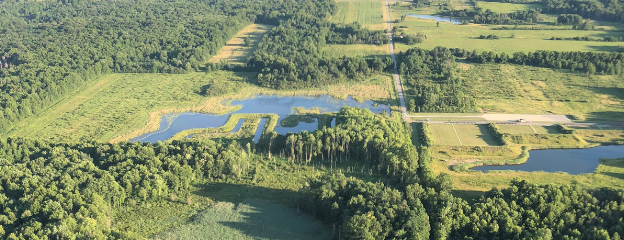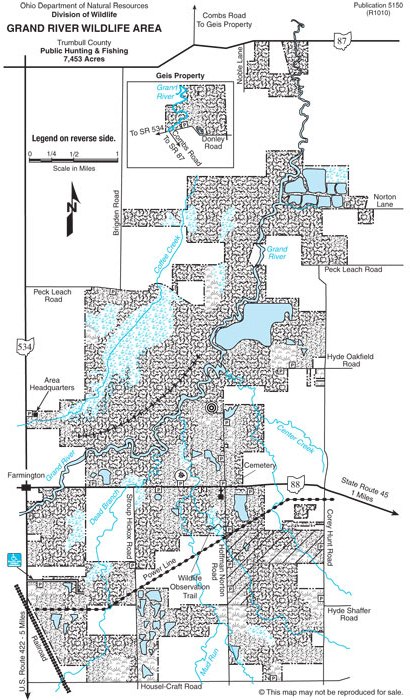Grand River Wildlife Area

Grand River Wildlife Area
6686 OH-534 West Farmington, Ohio 44491
Grand River Wildlife Area Official WebsiteGrand River Wildlife Area map
Grand River Public Access Guide
Also, see all the hotspots at:
Grand River-Lower Watershed Important Bird Area
Trumbull County Birding Drive
Tips for Birding
This large, state wildlife area is comprised of nearly 7000 acres. Approximately half is second-growth woodland, some quite mature, and mostly swamp forest. The southern half is more open with some cultivated areas. Marshy areas are scattered throughout and many were created by beavers, which are common here. The terrain is mostly flat and poorly drained. If you plan on hiking, bring boots to stay dry. The entire area is open to the public year around. The area is generally bounded by OH-45 on the east and OH-534 on the west.
The premier birding site in this Wildlife Area is the Norton Lane Ponds. Norton Lane runs west off of OH-45 about 3.5 miles north of OH-88. Follow it about a mile until it dead-ends at the parking area. This former fish farm is a complex of large, shallow ponds connected by mowed dikes that allow close-up views into the surrounding wetlands including a mature swamp forest along the southernmost dike and the Grand River itself on the west. The ponds have plentiful emergent vegetation that provides excellent cover for wetland birds. Notable breeding birds here include Pied-billed Grebe, Least Bittern, Common Moorhen, Sora, Virginia Rail, Blue-winged Teal, Hooded Merganser, and Marsh Wren. The surrounding woodland is great for migrant songbirds and breeding birds such as Cerulean Warbler.
Another notable location is a trail and boardwalk located off Hoffman-Norton Road (CR-213) one mile south of OH-88. There is a parking area on the east side of the road and the well-marked trailhead is across the road. The path is constructed of fine gravel and is well-drained. After crossing the marsh, it enters a mature, dry woodland. North of the parking lot is a large area of pine and spruce trees that may hold roosting owls.
Nearly all of the numerous small parking lots have trails leading from them into a variety of habitats. Maps of this site are also available near the main office at 6686 OH-534. They are in an outside display area and are available at any time.
From Warren, go north on either OH-45 or OH-534.
Open all year during daylight hours.
This wildlife area has the largest population of River Otters in the state. Norton Lane at daybreak is your best bet for viewing them.
Birds of Interest
Winter
This is the best season for raptors including Northern Harrier and Rough-legged Hawk as well as Northern Shrike. The best birding strategy is to slowly drive the numerous county and township roads that cross the area. The roads are lightly traveled and it is generally safe to stop along the edge of the road for a better look.
Spring
This can be an outstanding time for migrant waterfowl, beginning in late February. Norton Lane Ponds have had rarities such as Glossy Ibis during this season.
Summer
Good nesting species include the wetland birds mentioned above for Norton Lane. Notable nesting songbirds include Least and Alder Flycatcher, Prothonotary and Cerulean Warbler, and Swamp Sparrow. The mature woodlands hold large, healthy populations of several species of flycatchers, vireos, thrushes, and wood warblers.
Fall
Many of the same species may be seen as in the spring, but add shorebirds to the mix when water levels drop in the numerous ponds. Norton Lane can be a great spot for shorebirds.
About this Location
It is most helpful when submitting eBird observations at Grand River Wildlife Area to start a new checklist for each hotspot within the wildlife area. Use this general hotspot when you have a checklist that includes multiple locations or there was not a hotspot or personal location appropriate for your sightings.
About Grand River Wildlife Area
See all hotspots at Grand River Wildlife Area
The Grand River Wildlife Area is in northeast Ohio, just east of West Farmington. OH-88 bisects the area in an east-west direction, and OH-534 borders the area on the west. Trumbull CR-217, CR-213, and CR-233 run parallel to OH-534 through the area.
The 7,453-acre area is flat to gently rolling. Twelve ponds, numerous beaver impoundments, and over thirty constructed marshes can be found here. The Grand River and five tributary streams meander through the wildlife area, subjecting much of it to flooding during heavy rains and spring thaws. About 46 percent of the area is second-growth hardwoods, 49 percent is open land, cropland, and brushland, and 5 percent is wetland and water.
Purchase of land for this wildlife area began in 1956. A portion of the purchased land was cropland; today, much of it is in crop rotation to benefit wildlife. The primary purpose of the wildlife area is to provide public hunting and fishing. Other uses such as hiking and bird watching have become increasingly popular. Several constructed marshes have been impounded, totaling approximately 300 acres. The water levels in these wetlands are managed for waterfowl habitat during the fall migration; they also provide nesting sites for local migratory species.
Features
Roadside viewing
Restrooms on site
Wheelchair accessible trail
Entrance fee
Content from Grand River Wildlife Area Official Website and Ohio Ornithological Society
